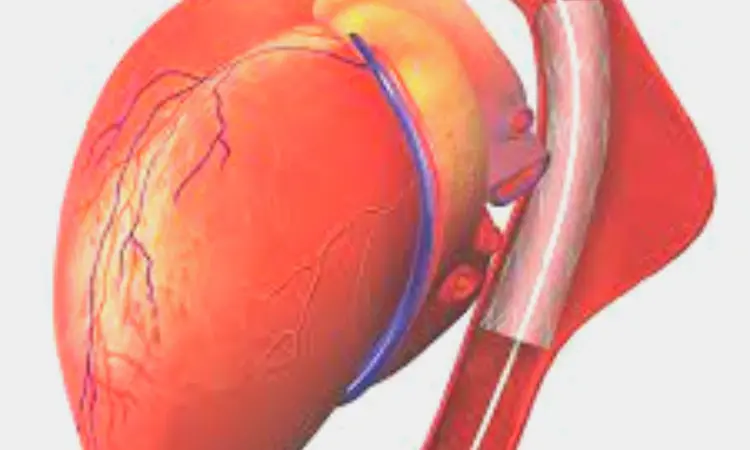- Home
- Medical news & Guidelines
- Anesthesiology
- Cardiology and CTVS
- Critical Care
- Dentistry
- Dermatology
- Diabetes and Endocrinology
- ENT
- Gastroenterology
- Medicine
- Nephrology
- Neurology
- Obstretics-Gynaecology
- Oncology
- Ophthalmology
- Orthopaedics
- Pediatrics-Neonatology
- Psychiatry
- Pulmonology
- Radiology
- Surgery
- Urology
- Laboratory Medicine
- Diet
- Nursing
- Paramedical
- Physiotherapy
- Health news
- Fact Check
- Bone Health Fact Check
- Brain Health Fact Check
- Cancer Related Fact Check
- Child Care Fact Check
- Dental and oral health fact check
- Diabetes and metabolic health fact check
- Diet and Nutrition Fact Check
- Eye and ENT Care Fact Check
- Fitness fact check
- Gut health fact check
- Heart health fact check
- Kidney health fact check
- Medical education fact check
- Men's health fact check
- Respiratory fact check
- Skin and hair care fact check
- Vaccine and Immunization fact check
- Women's health fact check
- AYUSH
- State News
- Andaman and Nicobar Islands
- Andhra Pradesh
- Arunachal Pradesh
- Assam
- Bihar
- Chandigarh
- Chattisgarh
- Dadra and Nagar Haveli
- Daman and Diu
- Delhi
- Goa
- Gujarat
- Haryana
- Himachal Pradesh
- Jammu & Kashmir
- Jharkhand
- Karnataka
- Kerala
- Ladakh
- Lakshadweep
- Madhya Pradesh
- Maharashtra
- Manipur
- Meghalaya
- Mizoram
- Nagaland
- Odisha
- Puducherry
- Punjab
- Rajasthan
- Sikkim
- Tamil Nadu
- Telangana
- Tripura
- Uttar Pradesh
- Uttrakhand
- West Bengal
- Medical Education
- Industry
Earlier prophylactic surgery preferable in selective nonsyndromic patients with thoracic aortic aneurysms: JAMA

USA: Findings from a study published in JAMA Cardiology back consensus guidelines recommending surgical intervention at prophylactic surgery in nonsyndromic patients with thoracic aortic aneurysm (TAA) at a threshold of 5.5-cm.
The study of a large sociodemographically diverse cohort of patients with thoracic aortic aneurysm (TAA) found a low absolute risk of aortic dissection that increased with larger aortic sizes after adjusting for potential confounders and competing risks.
There is no proper understanding of the risk of adverse events from ascending thoracic aorta aneurysms (TAA), but it drives clinical decision-making. Considering this, Matthew D. Solomon, Division of Research, Kaiser Permanente Northern California, Oakland, and colleagues aimed to investigate the association of thoracic aortic aneurysm (TAA) size with outcomes in nonsyndromic patients in a large non–referral-based health care delivery system.
The Kaiser Permanente Thoracic Aortic Aneurysm (KP-TAA) cohort study, a retrospective cohort study at Kaiser Permanente Northern California, a fully integrated health care system insuring and providing care for more than 4.5 million persons. The study included nonsyndromic patients from a regional TAA safety net tracking system. Merging imaging data with electronic health records (EHR) and comprehensive death data was done to obtain comorbidities, demographic characteristics, laboratory values, medications, vital signs, and subsequent outcomes.
Calculating unadjusted rates was done, and the association of TAA size with outcomes was investigated in multivariable competing risk models that classified TAA size as a baseline and time-updated variable and considered potential confounders.
Of 6372 patients with TAA (mean age, 68.6 years; 32.2% were females and 67.8%, mean initial TAA size was 4.4 cm (828 individuals had an initial TAA size of 5.0 cm or larger and 280 5.5 cm or larger).
Key findings of the study include:
- AD rates were low across a mean of 3.7 years of follow-up (44 individuals [0.7% of cohort]; incidence of 0.22 events per 100 person-years).
- In multivariable models, a larger initial aortic size was associated with higher AD risk and all-cause death risk, with an inflection point in risk at 6.0 cm.
- Estimated adjusted AD risks within 5 years were 0.3%, 0.6%, 1.5%, 3.6%, and 10.5% in patients with TAA size of 4.0 to 4.4 cm, 4.5 to 4.9 cm, 5.0 to 5.4 cm, 5.5 to 5.9 cm, and 6.0 cm or larger, respectively, in time-updated models.
- Rates of the composite outcome of AD and all-cause death were higher than for AD alone, but a similar inflection point for increased risk was observed at 6.0 cm.
"Our findings support consensus guidelines recommending surgical intervention at 5.5 cm in nonsyndromic individuals with TAA; given the minor risks linked with aortic surgery, earlier prophylactic surgery should be performed selectively in the nonsyndromic population," the researchers concluded.
Reference:
Solomon MD, Leong T, Sung SH, et al. Association of Thoracic Aortic Aneurysm Size With Long-term Patient Outcomes: The KP-TAA Study. JAMA Cardiol. Published online October 05, 2022. doi:10.1001/jamacardio.2022.3305
Dr Kamal Kant Kohli-MBBS, DTCD- a chest specialist with more than 30 years of practice and a flair for writing clinical articles, Dr Kamal Kant Kohli joined Medical Dialogues as a Chief Editor of Medical News. Besides writing articles, as an editor, he proofreads and verifies all the medical content published on Medical Dialogues including those coming from journals, studies,medical conferences,guidelines etc. Email: drkohli@medicaldialogues.in. Contact no. 011-43720751


